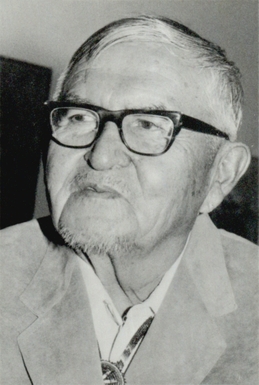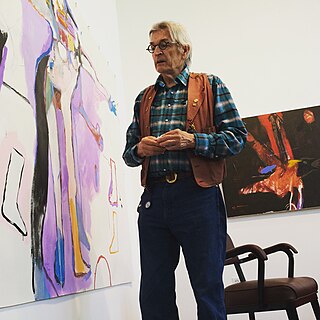Paul Jenkins was an American abstract expressionist painter.

Clement Meadmore was an Australian-American furniture designer and sculptor known for massive outdoor steel sculptures.

Kenny Scharf is an American painter known for his participation in New York City's interdisciplinary East Village art scene during the 1980s, alongside Jean-Michel Basquiat and Keith Haring. Scharf's do-it-yourself practice spanned painting, sculpture, fashion, video, performance art, and street art. Growing up in post-World War II Southern California, Scharf was fascinated by television and the futuristic promise of modern design. His works often includes pop culture icons, such as the Flintstones and the Jetsons, or caricatures of middle-class Americans in an apocalyptic science fiction setting.

Allan Capron Houser or Haozous was a Chiricahua Apache sculptor, painter, and book illustrator born in Oklahoma. He was one of the most renowned Native American painters and Modernist sculptors of the 20th century.
Charles Arnoldi, also known as Chuck Arnoldi and Charles Arthur Arnoldi, is an American painter, sculptor and printmaker. He was born April 10, 1946, in Dayton, Ohio.

Robert Brady is an American modernist sculptor who works in ceramics and wood. Born in Reno, Nevada, he has made his home in the San Francisco Bay Area for many decades. Brady is a multi-faceted artist who works in ceramics, wood, painting, and illustration, and is best known for his abstract figurative sculptures. Brady came out of the California Clay movement, and the Bay Area Arts scene of the 1950s and 1960s, which includes artists such as Peter Voulkos, Viola Frey, Stephen de Staebler, and Robert Arneson who was his mentor and teacher in college.

Richard Elmer "Rick" Bartow was a Native American artist and a member of the Mad River band of the Wiyot Tribe, who are indigenous to Humboldt County, California. He primarily created pastel, graphite, and mixed media drawings, wood sculpture, acrylic paintings, drypoint etchings, monotypes, and a small number of ceramic works.
Roger Edward Kuntz was a highly accomplished Southern California landscape painter and a member of the Claremont Group of painters - professors and graduates of Pomona College, Scripps College, and the Claremont Graduate School. A figurative artist with an eye for abstract form, he won critical acclaim for striking compositions that transform an unusual array of subjects, including tennis players, domestic interiors, freeways, road signs, bathtubs and the Goodyear Blimp. A retrospective exhibition of his work, at the Laguna Art Museum in Laguna Beach, CA in 2009, was aptly titled "Roger Kuntz: The Shadow Between Representation and Abstraction". In the exhibition catalogue, curator Susan M. Anderson wrote: "Kuntz's work of the late 1950s and early 1960s quintessentially embodied the experimentation, fragmentation, and paradox in American culture of the time."
Maxwell Hendler is an American painter. In 1975, he became the first contemporary artist to have pictures in the collection of the Metropolitan Museum of Art in New York.
Roland Conrad Petersen is a Danish-born American painter, printmaker, and professor. His career spans over 50 years, primarily in the San Francisco Bay Area and is perhaps best-known for his "Picnic series" beginning in 1959 to today. He is part of the Bay Area Figurative Movement.

John Fayette Frame is an American sculptor, photographer, composer and filmmaker. He has been working as an artist in California since the early 1980s. Frame has been given Grants and Awards from the National Endowment for the Arts, the J. Paul Getty Museum, and the Los Angeles County Museum of Art. He has participated in group exhibitions around the world and has had major solo exhibitions at the Los Angeles County Museum of Art, the Long Beach Museum of Art, and the Huntington Library, Art Collections, and Botanical Gardens. After five years of preparation, Part One of "The Tale of the Crippled Boy", a sweeping project incorporating sculpture, photography, installation, music and film, premiered at the Huntington Library in San Marino, California in March 2011.
Minoru Kawabata was a Japanese artist. Kawabata is best known for his color field paintings. Between 1960 and 1981, Kawabata had 11 solo shows at the prominent Betty Parsons Gallery in New York. At the 31st Venice Biennale in 1962, Kawabata’s work was exhibited in the Japan Pavilion alongside that of four other Japanese artists. Kawabata has had solo exhibitions at the Everson Museum of Art in 1974, the Museum of Modern Art, Kamakura in 1975, the National Museum of Modern Art, Kyoto and Ohara Museum of Art in 1992, and Yokosuka Museum of Art in 2011. Kawabata’s works are in the collection of the Albright-Knox Art Gallery, Artizon Museum, Everson Museum of Art, Museum of Contemporary Art Tokyo, the Museum of Modern Art, Kamakura & Hayama, the Museum of Modern Art, São Paulo, the National Museum of Art, Osaka, the National Museum of Modern Art, Kyoto, the National Museum of Modern Art, Tokyo, the Newark Museum of Art, Ohara Museum of Art, Solomon R. Guggenheim Museum, Yokohama Museum of Art, Yokosuka Museum of Art, among others.

Jazzamoart is a Mexican artist best known for his painting which is mostly connected to jazz music in some way. Born Francisco Javier Vázques Estupiñán in Irapuato, Guanajuato, his talent was recognized early and he took his professional name from his dual passions of jazz and art. He is best known as a painter with over 400 individual and collective exhibitions on several continents, but he has also done monumental sculpture, stage scenery and has collaborated with musicians. He lives in Mexico City.

George Herms is an American artist best known for creating assemblages out of discarded, often rusty, dirty or broken every-day objects, and juxtaposing those objects so as to infuse them with poetry, humor and meaning. He is also known for his works on paper, including works with ink, collage, drawing, paint and poetry. The prolific Herms has also created theater pieces, about which he has said, "I treat it as a Joseph Cornell box big enough that you can walk around in. It's just a continuation of my sculpture, one year at a time." Legendary curator Walter Hopps, who met Herms in 1956, "placed Herms on a dazzling continuum of assemblage artists that includes Pablo Picasso, Kurt Schwitters, Marcel Duchamp, and Joseph Cornell, as well as California luminaries Wallace Berman and Edward Kienholz." Often called a member of the West Coast Beat movement, Herms said that Wallace Berman taught him that "any object, even a mundane cast-off, could be of great interest if contextualized properly." "That’s my whole thing," Herms says. "I turn shit into gold. I just really want to see something I've never seen before." George Herms lives and works in Los Angeles.

Ferenc Csentery was an abstract metal sculptor known for his conceptual work related to the emergence of the US Space Program in the 1960s. He was particularly known for the high degree of technical precision of the machining and welding in his sculpture.
Gregory Amenoff is an American painter. He is located in the tradition of the early American Modernist painters Georgia O'Keeffe, Charles Burchfield, Milton Avery, Arthur Dove and Marsden Hartley. In the early 80s his work was often associated with a style of painting called organic abstraction and exhibited alongside artists Bill Jensen, Katherine Porter and Terry Winters.
Madokoro Akutagawa Saori was a Japanese painter whose works were often associated with primitivism, folkloric and mythological subjects, as well as unique dyeing techniques. Her paintings from the 1950s manifest various themes from distorted and dramatic portrayal of women to divine narratives based on traditional Japanese folklore. After briefly studying and living in the US, Akutagawa shifted her artistic exploration towards abstraction before her death at a young age in 1966.

Anthony Hanna Berlant is an American artist who was born in New York City. He attended the University of California, Los Angeles, where he received a BA (1961) and MA (1962) in painting and an MFA (1963) in sculpture. He has a large collection of Southwestern Native American art, especially Mimbres pottery and Navajo rugs. He lives and works in Santa Monica, California.

Jack Hooper was an American painter, muralist, sculptor, printmaker and art educator. Hooper was a major figure on the Southern California art scene, belonging to that generation of Los Angeles painters who matured during the late 1950s and the 1960s, painters such as John Altoon, Sam Amato, Robert Irwin, Lee Mullican, William Brice and Billy Al Bengston. He was an innovator in the use of new materials, most importantly plastic in art. He is known for abstract expressionist, mural and figurative painting. Hooper has exhibited in art museums and galleries nationally and internationally including solo shows in Europe, Mexico and the United States. Modeling renown UCLA art professor and figurative artist, Jan Stussy, the last 20 years of his life were spent in rural Mexico, where he drew and painted every single day until his death.
Kinuko Emi was a Japanese painter. Emi is best known for her abstract painting in bold colors featuring the motif of four classical elements. At the 31st Venice Biennale in 1962, Emi's work was exhibited in the Japan Pavilion alongside that of four male artists, making her the first Japanese woman artist to be shown at the country's Pavilion. She had retrospective exhibitions at the Yokohama Civic Art Gallery in 1996, the Museum of Modern Art, Kamakura in 2004 and Himeji City Museum of Art in 2010. Emi's works are in the collection of the National Museum of Art, Osaka, the Museum of Contemporary Art Tokyo, the Museum of Modern Art, Kamakura & Hayama, Yokohama Museum of Art, and Takamatsu Art Museum, among others. Emi's daughter, Anna Ogino, is an Akutagawa Prize-winning novelist and emeritus professor of French literature at Keio University, Tokyo, who serves as the custodian of her mother's works and legacy.











